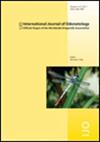Taxonomic notes on the genus Heliogomphus Laidlaw, 1922 (Odonata: Gomphidae), with a redescription of H. kalarensis Fraser, 1934 from southern India
IF 1
4区 农林科学
Q3 ENTOMOLOGY
引用次数: 1
Abstract
The taxonomy and distribution of dragonflies of the genus Heliogomphus from the Western Ghats of southern India are discussed. A morphological study of fresh male specimens from the field, as well as holotypes and lectotypes from repositories was undertaken. Contradictiing statements in scientific literature, we found that the markings on the occiput and thorax are not dependable features in distinguishing sympatric Heliogomphus promelas (Selys, 1873) and H. kalarensis Fraser, 1934. The structure of the epiprocts and the male genitalia were key features for differentiating them. Heliogomphus pruinans, Fraser, 1922 is removed from the synonymy of H. promelas and is synonymized with H. kalarensis instead based on the analysis of the structure of its epiproct. In accordance with the provisions of ICZN Article 23.9.1.2, in suppression of the unused senior synonym, the taxon name H. kalarensis is retained as a nomen protectum. Heliogomphus unifasciatus is treated as nomen nudum. Taxonomic notes and updated distribution summaries of the two species from the Western Ghats with an identification key to the males are provided. Heliogomphus kalarensis is redescribed from fresh field-collected specimens, including details of the male genitalia and anal appendages. Fieldwork in the Western Ghats revealed that H. kalarensis is the most common of the two Heliogomphus species in Kerala state. The published records of H. promelas and H. kalarensis from this region need to be revisited in light of the facts presented here.对1922年产于印度南部的gomhiomphus Laidlaw属的分类注释(蛾目:gomphae),以及1934年产于印度南部的H. kalarensis Fraser的重新描述
讨论了印度南部西高止山脉Heliogomphus属蜻蜓的分类和分布。对来自野外的新鲜雄性标本以及储存库中的正模和选模进行了形态学研究。与科学文献中的说法相矛盾的是,我们发现枕骨和胸部上的标记并不是区分同域的长腿猴(Selys,1873)和H.kalarensis Fraser,1934的可靠特征。上腹部和男性生殖器的结构是区分它们的关键特征。Heliogomphus pruinans,Fraser,1922从H.promelas的同义词中删除,并根据对其表序结构的分析,与H.kalarensis同义。根据ICZN第23.9.1.2条的规定,为了抑制未使用的高级同义词,分类单元名称H.kalarensis被保留为保护名称。单鳍海鳗被视为无鳍海鳗。提供了西高止山脉两个物种的分类注释和最新分布摘要,以及雄性的识别钥匙。卡氏Heliogomphus kalarensis是从野外采集的新鲜标本中重新描述的,包括男性生殖器和肛门附属物的细节。在西高止山脉的实地调查显示,卡拉伦H.是喀拉拉邦两种Heliogomphus中最常见的一种。该地区已出版的H.promelas和H.kalarensis的记录需要根据这里介绍的事实重新审视。
本文章由计算机程序翻译,如有差异,请以英文原文为准。
求助全文
约1分钟内获得全文
求助全文
来源期刊

International Journal of Odonatology
ENTOMOLOGY-
CiteScore
2.30
自引率
0.00%
发文量
15
审稿时长
>12 weeks
期刊介绍:
International Journal of Odonatology (IJO) is aimed at providing a publication outlet for the growing number of students of Odonata. It will address subjects such as the ecology, ethology, physiology, genetics, taxonomy, phylogeny and geographic distribution of species. Reviews will be by invitation, but authors who plan to write a review on a subject of interest to the journal are encouraged to contact the editor.
 求助内容:
求助内容: 应助结果提醒方式:
应助结果提醒方式:


